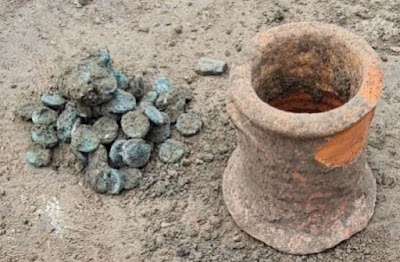Written by the TreasureGuide for the exclusive use of the Treasure Beaches Repot.
 |
| Cache of Greek Coins. |
80 copper staters—a type of Greek coin—were found in an amphora buried for centuries in the ashes of a calamitous fire. Researchers think they were stashed in the vessel prior to an attack, likely from the Huns or the Turks, that resulted in large sections of the city being torched...
“Treasures [like this] are not often found,” said archaeologist Vladimir Kuznetsov, who heads the institute’s now three-year-long Phanagoria dig, in a statement. “As a rule, they are evidence of catastrophic events in people’s lives, as a result of which the one who hid money or valuable items was unable to return and use their savings.”...
Here is the link for more about that.
===
When were screw top bottles invented? Without getting into a lot of detail the most common answer is 1858, and it was for Mason canning jars.
This is not a canning jar, but it is an early type of screw top. I found this E. R. Durkee and Co. Salad Dressing bottle Tuesday. I didn't think much of it at first, but after finding a lot of good information discovered it was older than I originally thought.
 |
| E R DURKEE and CO SALAD DRESSING BOTTLE. |
It seems to date to around 1900, although it could be earlier.
It is a blown bottle with some nice bubbles in the glass.
It has an early externally threaded screw top, which is something that originally threw me off. It is different in several respects from more modern screw tops. I mistakenly thought it was a newer bottle when I first picked it up.
 |
| E R Durkee and CO Salad Dressing Bottle. |
It is slightly sun-purpled, which is something that surprised me before I knew how old it is. The turn of color is the result of manganese dioxide, which was used during manufacture to create clear glass.
The glass maker marks on the bottom are also interesting. The bottle has the patent date clearly written out as April 17 1877.
 |
| Patent Date On Durkee Bottle. |
Eugene R. Durkee – making spices and extracts in his basement at home – at 1850, and we have seen an advertisement for the firm as early as 1851 – the year given by most sources. The early ad noted that E.R. Durkee (no “& Co.”) was a “Wholesale and Retail Dealer in Drugs, Medicines, Perfumery, Brushes, Fancy Articles, Glassware, Congress Water, Leeches, Cigars, Pure Wines, Liquors, Oils, Camphene, Burning Fluid &c.” in Buffalo, New York. The only products specifically linked to his name were Durkee’s Venetian Liquid Hair Dye, Durkee’s Vermifuge, and Durkee’s Baking Powder (Matt’s Collectibles 2014) (Figure 1). Durkee developed his salad dressing during this period, probably in 1857, and won awards for it (Kovel 2010; Museum of the City of New York 1999:71)...
Here is the link for that information and much more.
---
Another bottle I picked up Tuesday is this blown American Bottle Company bottle. It also has some nice size bubbles.
 |
| Old American Bottle Company Bottle. |
 |
| Embossed Bottom of Same American Bottle Company Bottle Showing AB and K13 |
The K probably indicates the plant, and the 13, the year.
This can get confusing because the American Bottle Company could easily be confused with the Adulphus Busch Glass Manufacturing Company or Anheuser Busch, the beer, which can be more confusing yet, because there were relations between the three.
The mold seams tell a lot.
The 1908 image to the right [above] was taken at the Seneca Glass Works in Morgantown, WV. and shows a gaffer (with the blowpipe) at work with his "mold tender" boy (seated). The mold boy (aka a servitor) would open and close the mold (at the base of the pipe behind the wash tub) as directed by the gaffer. In front of the gaffer in this image (to his right) is the chair where much work was done with blowpipe manipulation prior to lowering the parison into the mold expansion. A second boy looks on with (possible) admiration of the gaffer as they were the highest paid and most elite workers on the glass factory floor and among the highest paid of all skilled laborers during the 19th century (Barnett 1926). Being a gaffer was also the position that glass factory boys aspired towards (Skrabec 2007). Directly in front of the standing boy is most likely the marver which was a flat table used for parison manipulation. The caption to the photo is: "Blower and Mold Boy, Seneca Glass Works, Morgantown, W. Va. Location: Morgantown, West Virginia." (Lewis Hine photo, Library of Congress)...
[Picture and paragraph from senecaglassgaffer.jpg (664×937) (sha.org)]
---
